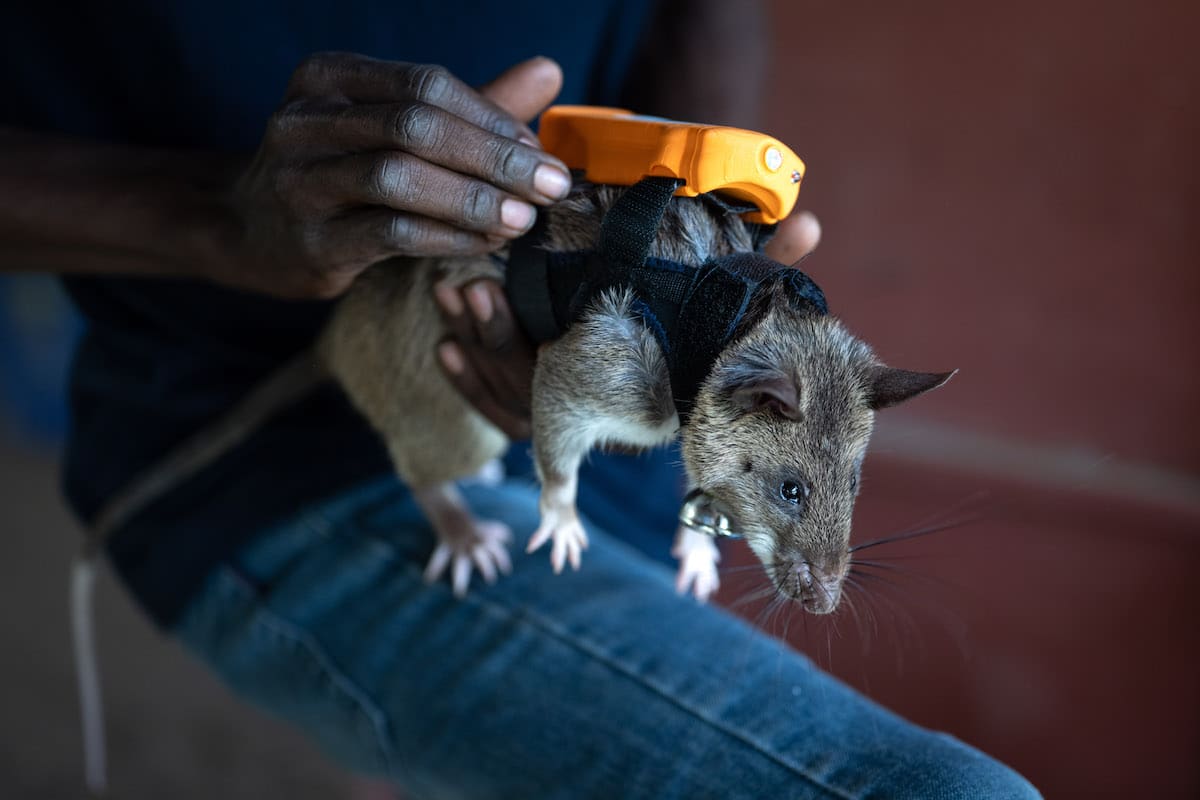In the cult classic film The Princess Bride, the heroes brave the Fire Swamp and come face to face with a fearsome enemy: R.O.U.S. — Rodents of Unusual Size. These fictional creatures are portrayed as monstrous, oversized rats that leap from the shadows to attack without warning. Alongside them lurked other dangers such as flame spurts and the lightning sand pit, making the swamp a place of constant peril for the Dread Pirate Roberts and Princess Buttercup.
It’s a scene played for thrills and laughs, but it also left a cultural footprint. For many people, the phrase “rats of unusual size” conjures up images of dangerous, oversized pests best kept at a distance. But what if we told you that Rodents of Unusual Size are real? And not only are they real, but, unlike their scary fictional counterparts, they’re also saving lives across the world.
Meet the real ROUS: APOPO’s HeroRATs
APOPO’s HeroRATs are African giant pouched rats trained to detect landmines, tuberculosis (TB), and even illegal wildlife products or people buried under rubble (RescueRATs). They may not lurk in swamps or leap from trees, but they do something far more impressive. They help clear deadly explosives, diagnose disease, protect endangered animals, and find victims of natural disasters.
These real rats of unusual size aren’t fictional villains. They’re real-life heroes.
What Exactly Is an APOPO HeroRAT?
Here’s a quick zoology lesson: APOPO’s HeroRATs belong to a species called the African giant pouched rat (Cricetomys ansorgei). Native to sub-Saharan Africa, these ‘rodents of unusual size’ are known for their large cheek pouches, strong sense of smell, and surprising intelligence.
What’s in a (common) Name?
At present, the rats bred and trained at APOPO are classified as Cricetomys ansorgei. The common name for this species varies between sources — both “African giant pouched rat” and “Southern giant pouched rat” are used in academic literature and online publications to describe Cricetomys ansorgei. APOPO chooses to use the term African giant pouched rat, reflecting both the species’ continental range and the Tanzanian origins of our training and research programs.
They are, indeed, unusual in size. They typically weigh between one and one and a half kilograms and grow up to 80 centimeters long, including their tails. That makes them much larger than the common brown rat and a perfect candidate for APOPO’s unique scent detection work. The rats are lightweight enough not to trigger landmines. They are intelligent and curious, able to learn complex tasks through clicker training and food rewards. They’re also clean, social, and easy to care for.
Despite the reputation of rats in general, these giants are gentle animals and often develop strong bonds with their handlers.
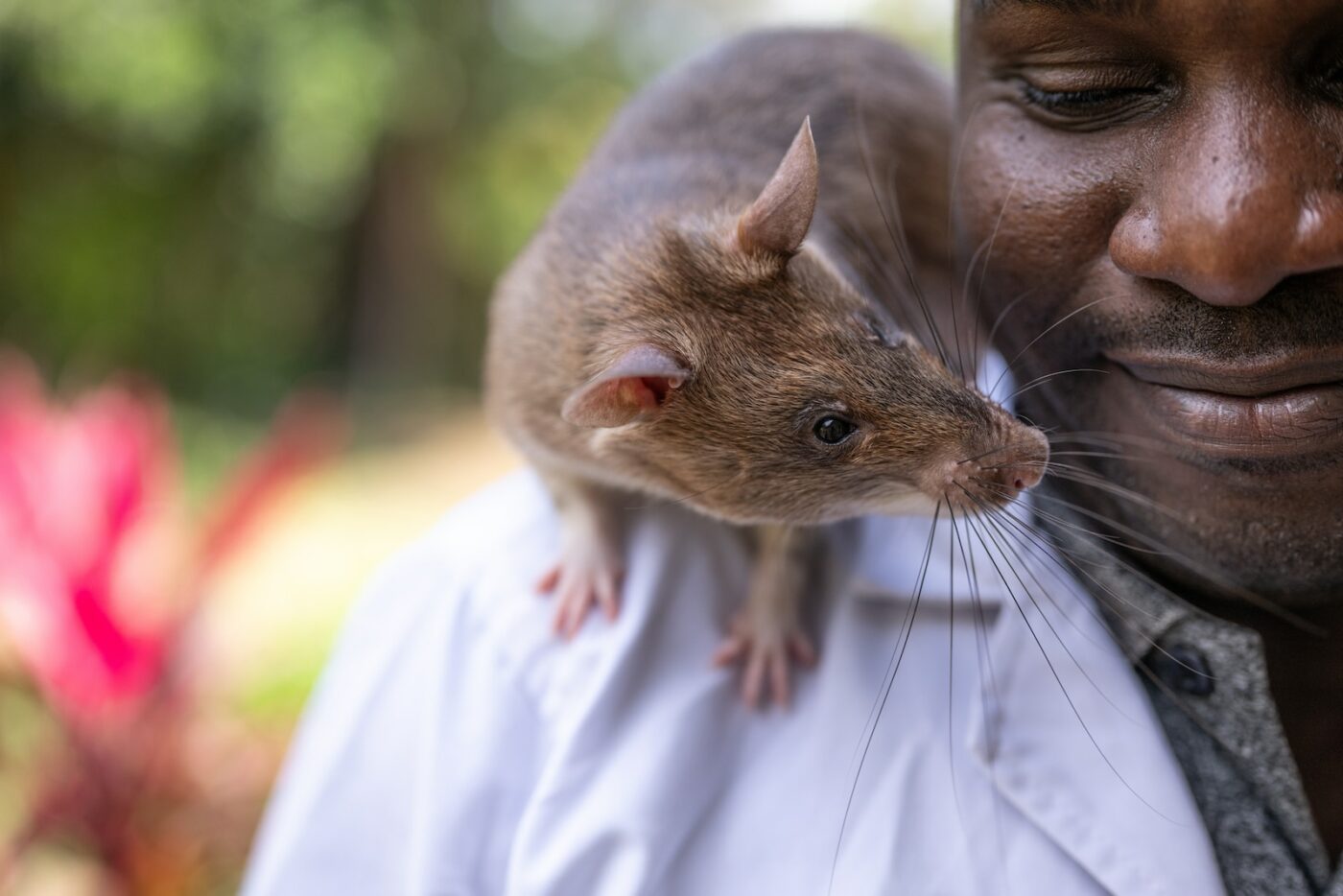
From Fictional Rodents to Real-Life Rescuers
APOPO’s story begins in Belgium in the 1990s, when our founder first explored the idea of using scent-detection animals for humanitarian purposes. African giant pouched rats were identified as an ideal species for this work because of their strong olfactory skills, intelligence, and relatively long lifespan. The project soon moved to Tanzania, where conditions allowed the program to take root and grow.
Today, APOPO’s HeroRATs are trained at our Training Center in Morogoro, Tanzania. It’s here that young rats begin their journey from curious pups to professional detection animals. After about 10 weeks of age, they start formal training in one of two primary areas.
Landmine Detection
HeroRATs are trained to detect the scent of explosives in buried landmines and unexploded ordnance. They walk along search lanes in the field and learn to pause when they detect a target. Unlike metal detectors, which can be triggered by harmless scrap metal, rats detect the specific smell of explosives, allowing them to work faster and more accurately in many settings.
In 2024, APOPO’s training rats searched 477,981 square meters of land, found 19,128 explosive targets, and earned 16,046 banana rewards for their correct indications. That same year, 23 rats earned internal accreditation and 20 were deployed to Cambodia. In less than six months, these rats located 75 landmines and other explosives while safely clearing nearly 300,000 square meters of contaminated land.
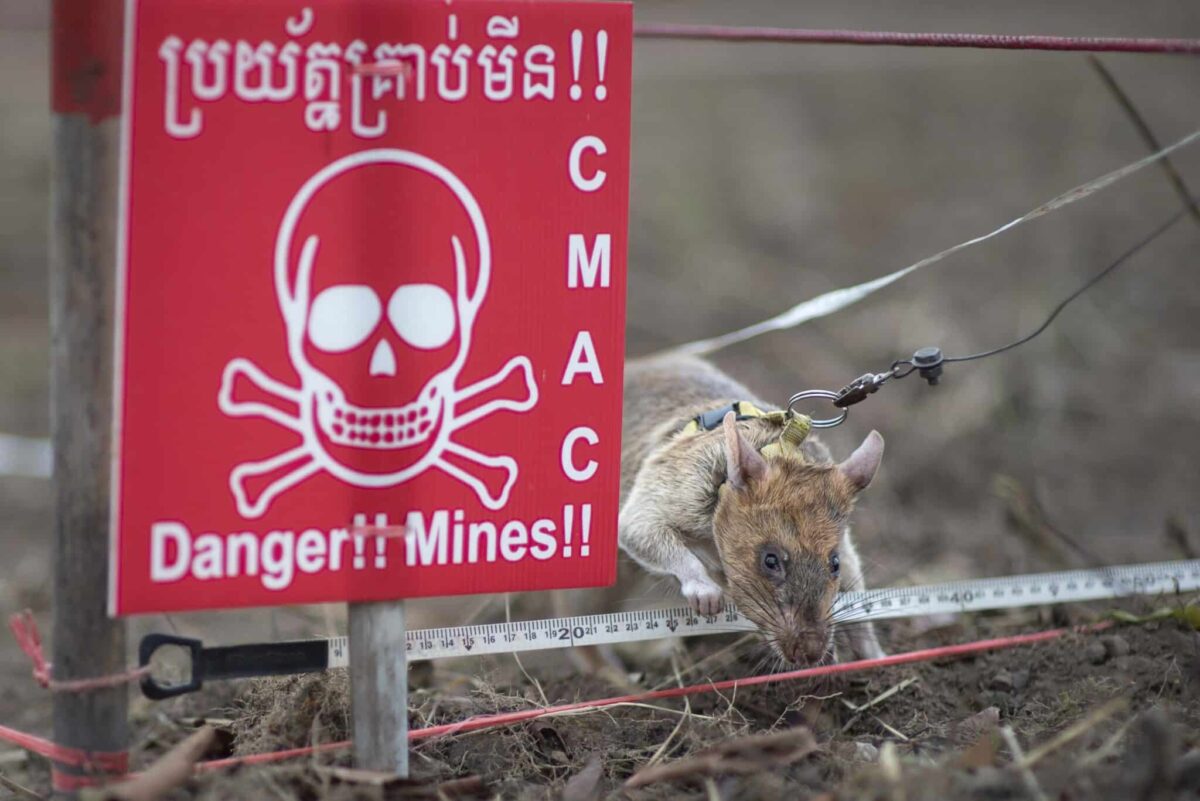
Beyond saving lives, this work reduces the human and ecological consequences of landmines, allowing communities to return to farming and rebuild their environments.
Read stories about the people who benefit from the HeroRATs mine detection work
Tuberculosis Detection
In the fight against disease, the HeroRATs also play an important role in tuberculosis (TB) detection. APOPO trains rats to sniff human sputum samples and identify those that contain TB-positive markers.
A single rat can screen 100 samples in under 20 minutes. That’s much faster than traditional laboratory tests and especially useful in regions with limited diagnostic tools. Importantly, HeroRATs are used as a second-line method — they test samples that were initially declared negative by microscopy but come from patients who still show symptoms.
In 2024, 18 rats completed their TB detection training. One retired HeroRAT named Carolina worked for nearly seven years, screening 209,116 samples and helping identify 3,126 TB-positive patients who were missed by clinics.
Read about people who have benefitted from the HeroRATs TB detection work
Why Use Rats?
HeroRATs offer several advantages over traditional methods. They are too light to trigger landmines, making them a safe choice for mine action. They work quickly and can search an area the size of a tennis court in around 20 minutes. A manual deminer using a metal detector would take up to four days to cover the same area.
The HeroRATs are also cost-effective. Compared to mine detection dogs or high-tech equipment, rats are relatively inexpensive to breed, train, and maintain. Their size and adaptability allow them to work in a variety of environments with minimal infrastructure.
They remain fit and adaptable throughout their working lives thanks to good care, and with a structured breeding program and standardized training, APOPO can prepare new HeroRATs for our programs on an ongoing basis.
The Training Process
HeroRAT training begins with socialization. Rat pups stay with their mothers for the first four weeks, then begin exploring and interacting with humans in a safe environment, learning that human handling and different environments are safe for them. At 10 weeks, formal training begins.
Trainers use clicker training and positive reinforcement to teach the rats how to detect specific smells. Clicker training involves using a small handheld device that makes a distinct “click” sound whenever the rat performs the correct behavior. The click is immediately followed by a food reward, such as banana or peanut paste, so the animal learns to associate the sound with a positive outcome. Over time, the rats understand that performing the desired action — like pausing at the scent of TNT or a TB-positive sample — will earn them a click and a treat.
For landmine detection, they learn to recognize the molecular odor of explosives such as TNT and other compounds commonly found in buried devices. For TB detection, the rats sniff rows of sputum samples to identify the volatile organic compounds released by the tuberculosis bacterium. By focusing on these molecular odors, the rats can work quickly and accurately, even when traditional tools or human senses fall short.
A Strong Commitment to Animal Welfare
At APOPO, the wellbeing of our animals is at the center of everything we do. In 2024, we formally adopted Animal Welfare as one of our Core Values, strengthening a commitment that has always guided our work. For us, animal welfare means more than just providing food and shelter. It means ensuring that every rat has a safe, stimulating environment with opportunities to explore, play, and express natural behaviors. We provide comfortable housing, balanced nutrition, and regular veterinary care, and we continually introduce enrichment items like toys, climbing structures, and interactive activities to keep our rats active and engaged.
We have also digitized health records so that every rat’s condition can be carefully monitored and tracked over time, ensuring no detail is overlooked. Across all of our programs we share best practices and set high standards, so whether a rat is in training or deployed in the field, it receives the same level of care. When a HeroRAT retires, it remains in our care — either at our Training Center or with its handler team in the field — continuing to receive the food, attention, and veterinary support they deserve.
Our HeroRATs are not just tools, they are partners. Unlike the frightening depictions of rodents in fiction, our rats live enriched, well-cared-for lives during and after their service.
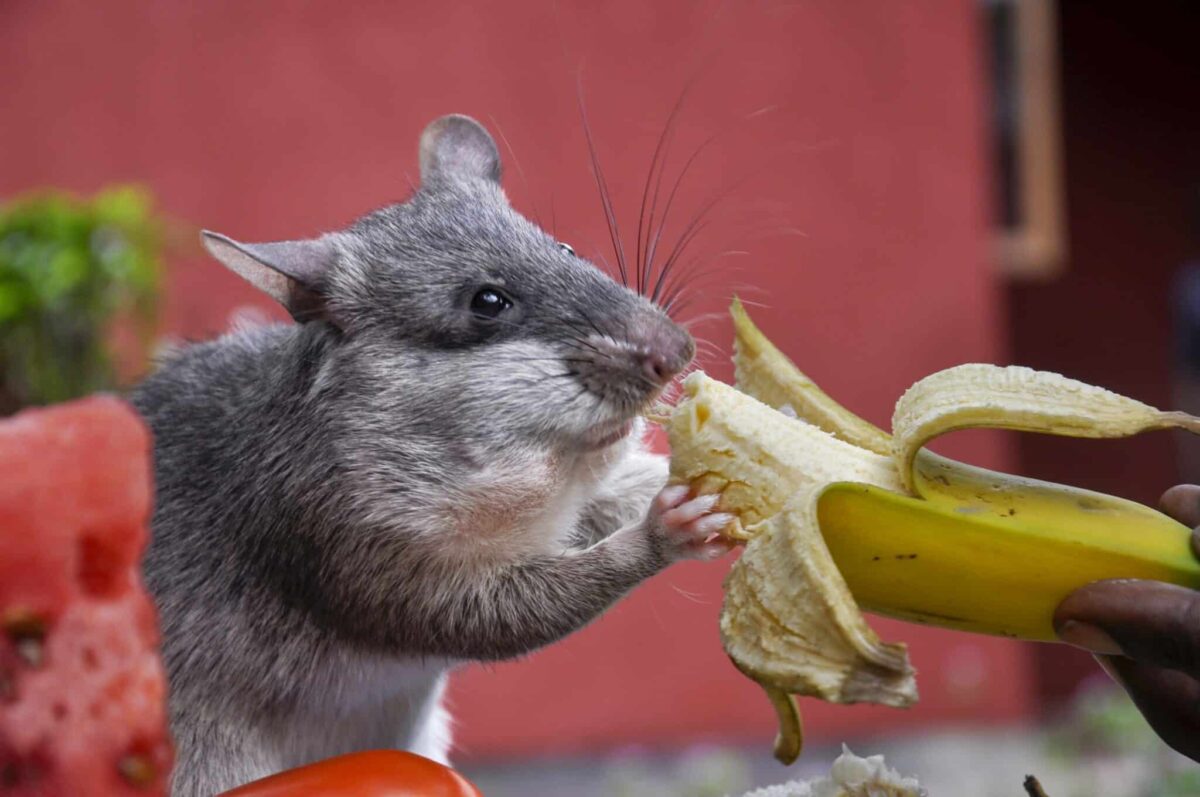
A Global Impact
Since its founding and until the end of 2024, APOPO’s HeroRATs have helped clear over 122 million square meters of land and locate nearly 170,000 landmines and explosives. In the health sector, they’ve screened over 640,000 patients and helped identify more than 33,000 additional TB cases.
In 2024, APOPO also expanded trials for wildlife detection. At a seaport, HeroRATs successfully detected illegal wildlife products such as pangolin scales and rhino horn. In trials, team-based strategies achieved a 100 percent detection rate.
Search and rescue training is also underway. Rats are being trained to locate survivors in collapsed buildings, with trials planned in Türkiye for 2025.
Not Just Unusual — Exceptional
In The Princess Bride, Rats of Unusual Size were fictional monsters. But APOPO’s real-life R.O.U.S. are anything but monstrous. They are trained professionals working in some of the world’s most dangerous and underserved places.
Unusual? Yes. Large? Yes.
But more importantly, exceptional.
These real rodents of unusual size are making the world safer and healthier, one sniff at a time.
Adopt Your Own ROUS — A Real HeroRAT
In The Princess Bride, Rodents of Unusual Size were the stuff of legend. At APOPO, our real-life ROUS are heroes working every day to make the world safer. By “adopting” a HeroRAT, you can follow their journey, receive updates and photos from the field, and directly support their training, active deployment, and care.
Your adoption helps fund life-saving work — from clearing landmines to detecting tuberculosis — and ensures these extraordinary animals continue to make an impact.
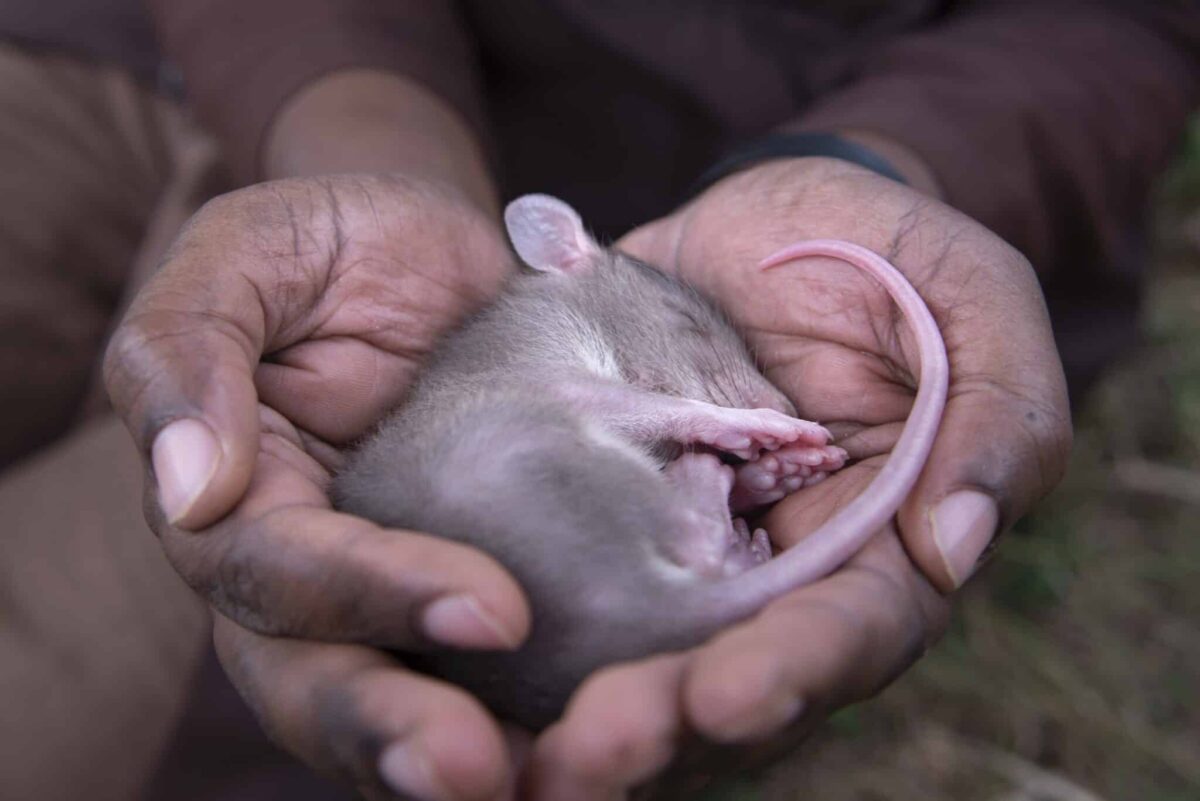
FAQ: HeroRATs and Rodents of Unusual Size
Do APOPO’s HeroRATs ever trigger landmines?
No. They are far too light to set off the types of landmines still buried in former conflict zones. Their ability to safely search contaminated land is one of the reasons they are so effective compared to other detection methods.
How long does it take to train a HeroRAT?
Most rats complete their training in 9 to 12 months. During this time they learn, through clicker training and food rewards, to detect the molecular odor of explosives or the volatile compounds released by tuberculosis bacteria.
What happens when a HeroRAT retires?
When a rat finishes its working life, it stays in APOPO’s care. Retired HeroRATs receive food, enrichment, and veterinary support for the rest of their lives.
Why does APOPO use rats?
Rats combine traits that make them uniquely suited to humanitarian detection. They are too light to trigger landmines, their strong sense of smell allows them to work quickly and accurately, and they are inexpensive to breed, train, and care for compared to dogs or machines.
Does APOPO also work with other animals besides rats?
Yes. In addition to our HeroRATs, APOPO runs a HeroDOGs program. HeroDOGs complement the work of the rats — together they make mine action faster, safer, and more efficient. Both programs share the same commitment to animal welfare, using positive reinforcement and ensuring the dogs, like the rats, receive excellent care throughout their working lives and retirement. While dogs are heavier than rats, their training teaches them to indicate they have detected the scent of an explosive by stopping around a meter away from the target scent. This means they are completely safe when working and no dog has ever been injured or killed in APOPO’s mine detection operations.
Can I keep a HeroRAT as a pet in the United States?
Generally no. U.S. laws on exotic animals vary by state, but in most cases African giant pouched rats are not allowed to be imported as pets. These restrictions are designed to prevent invasive species problems and to protect native wildlife. A clear example of what can happen when exotic animals are introduced comes from the nutria, a large South American swamp rat originally brought to the U.S. for the fur trade. Nutria escaped into the wild and became invasive, causing extensive damage to coastal wetlands, irrigation systems, and fisheries, while also contributing to coastal erosion in Louisiana. To avoid repeating this kind of ecological problem, regulations prevent APOPO’s rats from being kept as domestic pets.
How does APOPO ensure animal welfare?
Animal welfare is one of APOPO’s Core Values. Our rats live in cozy environments, receive regular veterinary care, balanced nutrition, daily playtime and interaction with trainers. Retired rats are cared for throughout their lives, showing our commitment to them as partners, not tools.
What about the scary rodents in The Princess Bride?
The Rodents of Unusual Size in The Princess Bride are fictional monsters created for entertainment. Our real-life HeroRATs are gentle, socialized animals who save lives every day. Pop culture often blurs the line between myth and reality, which is why APOPO emphasizes education about what these animals can truly do.
Have rodents of unusual size appeared elsewhere in the media?
Yes. The environmental documentary Rodents of Unusual Size, produced by Jeff Springer, Quinn Costello, and Chris Metzler through Tilapia Film, tells the story of invasive nutria in South Louisiana and their impact on coastal wetlands, cajun culture, Native Americans, and the fur trade. In gaming, Fallout New Vegas features ROUS in Wild Wasteland encounters, and in live events actors such as Danny Blackner have recreated the monstrous swamp rats. These depictions show how giant rodents fascinate audiences — but unlike fictional or invasive species, APOPO’s HeroRATs are trained for humanitarian work. Fans still discuss the size of the ROUS on Q&A communities like the Stack Exchange Network, sometimes even debating whether “R.O.U.S.” looks better in small font size or light mode in a browser window. This is the level of detail these creatures inspire.
Can I stream films about rodents of unusual size?
Yes. The documentary Rodents of Unusual Size has reached audiences worldwide, complete with an original score available on Compact Disc, unlimited streaming, high-quality download, and even the option to download in MP3. And if you’d like to see APOPO’s real-life HeroRATs in action, you can follow our social channels to watch regular videos of these incredible animals at work and play.
Adopt a HeroRAT today and join us in turning unusual size and exceptional sniffing skills into humanitarian service.

